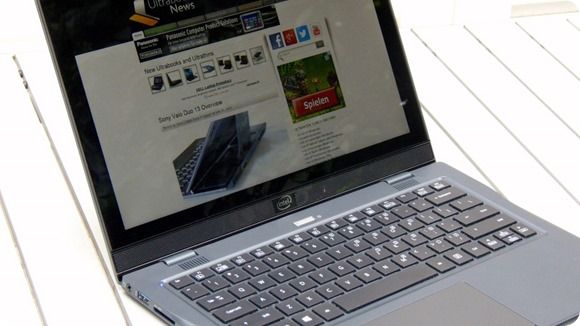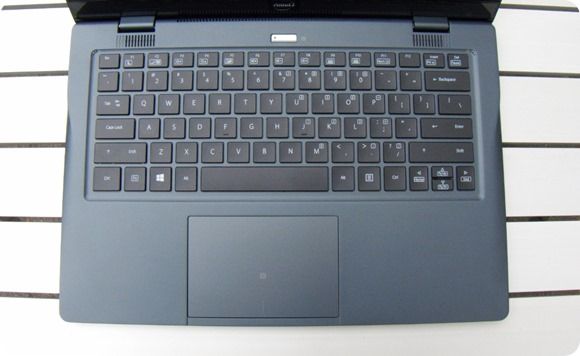
[Guest post by David Gilson]
While Microsoft is going all-in with its “Modern UI”, the dual nature of Windows 8 is still trying the patience of many. This is partly due to the fact that most consumer laptops lack a touchscreen. Fortunately, Chippy was kind enough to loan me his 2013 Harris Beach developer Ultrabook after seeing me bemoan the “dual nature” of Windows 8. Here’s how a touchscreen device has changed my feelings about Redmond’s tiled interface.
David Gilson – Background
I’m a mobile tech enthusiast. It all started with Psion palmtops, for which I wrote shareware and freeware. I now write as a tech journalist for a number of sites including CNET UK. Right now, my primary devices are the Nexus 5 and the iPad Mini.
My current laptop, which I’ve had for a few years, is a 14″ Acer Timeline 4820T. It’s a good laptop, and I’ve upgraded it with 8GB of RAM and a hybrid hard drive. All of that has helped to compensate for the first-gen Core i3 processor. However, nothing can compensate for its 2.5KG mass. While that’s not terrible, it becomes a bit much for commuting with, as I’ve been doing a lot this year.
In steps the Harris Beach Ultrabook with a 2013 Core i5 processor, 4GB of RAM, 160GB SSD, and most importantly (for this article) a 14″ touchscreen. It also manages to shed a whole kilogram compared to my Acer Timeline. This is the sort of machine I need for carrying to my co-working centre.
The trouble with Windows 8.0
One of the key issues that Windows 8 brings up is the dual nature of the modern touch interface and the traditional desktop mode. Microsoft needs the desktop interface, there’s too much legacy software out there. Furthermore, Windows 8 without desktop application compatibility becomes Windows RT which has yet to enjoy much success in the consumer market, as evidenced by Microsoft’s billion dollar write-down of the Surface RT.
Considering the lack of popularity for Windows RT, many could reasonably claim that the whole touch interface of Windows 8 is a flop. I would be hesitant to agree – even though Windows 8 has almost driven me to OSX or Ubuntu.
As you might be expecting from this article, I am testifying that having a touchscreen makes Windows 8 make much more sense and gives a smoother transition between desktop and modern user interfaces.
Desktop interfaces (not just Windows) have always suffered from the need to ‘mouse around’ – the repeatedly moving a pointing device in a certain direction to get the cursor where it’s needed. With the modern interface of Windows 8 this was exacerbated as one had to drive the cursor around to emulate some touch gestures. For example, dragging a secondary app to share the screen with current application. This happens because touchpads (or the area in which a mouse can be moved around) do not provide a one to one map of the screen – whereas that’s exactly what touchscreens do.
I had originally been a supporter of the new Windows 8 user interface. However, all of the above combined with constantly working out whether I needed to be on the desktop or the modern UI space, meant that Windows 8 without touch was slowly grinding down my patience.
The trouble with Windows 8.1
I should say that the first thing I did when I received this Ultrabook for review was install Windows 8.1. Therefore, I have been using this with the multi-size split-screen facility. While this is a most welcome update, I’m not happy with the way that Microsoft has implemented it.
The split-screen update to Windows 8.1 was supposed to allow up to four apps to be on screen at once – depending on resolution. Given that the Harris Beach Ultrabook has a 1920×1080 resolution – the [current] highest that you’ll find on a non-Apple laptop – you’d think it could manage four apps on screen. It can’t though, the most Windows 8.1 would allow is three. That means that lower resolution laptops (e.g. 1366×768) are still only going to show two apps on screen at once. Indeed, the area that each app occupies can be changed, but it’s still limiting to only have two apps on screen at once. For example, while using the Harris Beach Ultrabook, I found myself having Skype and Twitter in two narrow columns, while working on the desktop in a 66% slice of the screen.
Touch makes a difference.
At the risk of sounding like an evangelist for Microsoft’s design department (which I’m not) – having touch really does save the day.With a pointing device you can perform nearly all of the same gestures that you can with a touchscreen. Apart from swiping in from the left of the screen to switch apps. This actually makes a big difference to your work-flow. With a pointing device you have to hover on the left to get the switcher list (and likewise for the charms bar on the right), and that makes for a stilted experience.
Note that the Harris Beach touchpad drivers does allow for swiping in from the left to switch apps – I do not know how common this is on consumer laptops though.
Furthermore, while the Windows desktop is far from touch-optimised, it is still entirely possible to interact with it by touch. Therefore, the difference between switching from modern UI apps to desktop apps is much less jarring. Furthermore, using touch on desktop apps does not feel quite as unnatural as using a mouse apps designed for touch. Yes, this is subjective, so your mileage may vary.
Touchscreen vs. Touchpad.
When he introduced the iPad, Steve Jobs criticised the idea of a touchscreen laptop as being uncomfortable to use. As I’ve been talking about using the Harris Beach ultrabook on Twitter, a term that has appeared in many replies is that of “Gorilla arm” – which of course refers to posture rather than being any sort of personal remark!
Of course, holding your arm up to a screen all the time would be tiring. However, that is not how you use a touchscreen laptop.
In my experience there are two scenarios. Firstly, you use the “Gorilla arm” posture to perform a few gestures in preparation for extended keyboard work. For example, open the Mail client and select an email to reply to, then type your reply. Secondly, is the “leisure mode”, where might be playing a game or reading from an app. In this case, you’ll have your hands lightly grasping the sides of the screen with your thumbs touching the sides of the screen – which Windows 8 is perfectly designed to accommodate.
In short, I never needed to use the touchscreen for so long that my arms felt tired with the Harris Beach Ultrabook.
Next we come to the argument that a touchscreen is not necessary with a high quality touchpad. Here, it seems as if the assumption that the touchscreen has to be replacing the touchpad. That really isn’t the case though.
As mentioned above, having to push the cursor around can get quite laborious, and so being able to reach out and directly interact with the user interface element you’re aiming for saves time and feels more natural.
The other side to this argument is that there are some activities are not suited to touch. This is mostly on desktop applications, where touch just isn’t precise enough, both because a fingertip is too large and because one may not be able to hold their arm steady enough for long enough. Of course, performing a “right-click” gesture with touch is definitely sub-optimal. In such a case, a touchpad is far more desirable, as you can be precise, you can hover without moving, and you can right-click.
So in this epic battle of input methods which is best? Which would win in a fight? Well, I’m afraid it’s a nonsensical question. Both input methods are useful in different scenarios – it’s a case of the right tool for the right job – and so touchpads and touchscreens complement each other. We need both!
Hardware comments.
So there’s my thesis on touch-enabled user interfaces, but what about the Harris Beach Ultrabook? Personally, it was very nearly the ideal laptop for me. It is thin and light, and it has amazing battery life. On light usage, I got a couple of days out of this machine. Also, I was pleasantly surprised by the very compact charging brick – about the same volume as a pack of cards.

It only has two USB ports, which means you would have to use the supplied USB to Ethernet adapter for a wired network connection. I found myself using that a lot as the WiFi performance on this unit wasn’t great, but that is mostly due to the fact that its drivers aren’t final. I also found that Windows 8.1 did not work with the (also unfinished) ACPI drivers – I could never wake up the screen from sleep and had to force-reboot. That wasn’t a hardship as this machine boots up extremely quickly.
[Update from Chippy: The Windows 8.1 update broke standby and Connected Standby. Sorry David! A fresh install has fixed that.]
If I could change one thing about the Harris Beach, I’d make it so that the keyboard was detachable, so that I could use it in tablet mode too.
Closing thoughts.
First of all, I’d like to thank Chippy for being kind enough to not only lend this machine to me, but to ship it from Germany to the UK. It’s been a very interesting experience that will inform my next few buying decisions. The Dell Venue 8 Pro looks interesting!
I think Windows 8’s touch interface is shaping up quite nicely, and it will provide a compelling experience someday, but it’s not quite there yet.
I’m also left with a dilemma about what should be done with the desktop environment. I can’t imagine doing without it, but perhaps that will change when the provision of Windows 8 touch apps improves.










